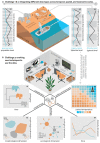Challenges and directions in analytical paleobiology
- PMID: 37809321
- PMCID: PMC7615171
- DOI: 10.1017/pab.2023.3
Challenges and directions in analytical paleobiology
Abstract
Over the last 50 years, access to new data and analytical tools has expanded the study of analytical paleobiology, contributing to innovative analyses of biodiversity dynamics over Earth's history. Despite-or even spurred by-this growing availability of resources, analytical paleobiology faces deep-rooted obstacles that stem from the need for more equitable access to data and best practices to guide analyses of the fossil record. Recent progress has been accelerated by a collective push toward more collaborative, interdisciplinary, and open science, especially by early-career researchers. Here, we survey four challenges facing analytical paleobiology from an early-career perspective: (1) accounting for biases when interpreting the fossil record; (2) integrating fossil and modern biodiversity data; (3) building data science skills; and (4) increasing data accessibility and equity. We discuss recent efforts to address each challenge, highlight persisting barriers, and identify tools that have advanced analytical work. Given the inherent linkages between these challenges, we encourage discourse across disciplines to find common solutions. We also affirm the need for systemic changes that reevaluate how we conduct and share paleobiological research.
Conflict of interest statement
Declaration of Competing Interest The authors declare no competing interest.
Figures


Similar articles
-
The 2023 Latin America report of the Lancet Countdown on health and climate change: the imperative for health-centred climate-resilient development.Lancet Reg Health Am. 2024 Apr 23;33:100746. doi: 10.1016/j.lana.2024.100746. eCollection 2024 May. Lancet Reg Health Am. 2024. PMID: 38800647 Free PMC article. Review.
-
A Plea for a New Synthesis: From Twentieth-Century Paleobiology to Twenty-First-Century Paleontology and Back Again.Biology (Basel). 2022 Jul 26;11(8):1120. doi: 10.3390/biology11081120. Biology (Basel). 2022. PMID: 35892976 Free PMC article.
-
Strategies for advancing inclusive biodiversity research through equitable practices and collective responsibility.Conserv Biol. 2024 Dec;38(6):e14325. doi: 10.1111/cobi.14325. Epub 2024 Aug 6. Conserv Biol. 2024. PMID: 39105487 Free PMC article.
-
The future of Cochrane Neonatal.Early Hum Dev. 2020 Nov;150:105191. doi: 10.1016/j.earlhumdev.2020.105191. Epub 2020 Sep 12. Early Hum Dev. 2020. PMID: 33036834
-
Welcoming More Participation in Open Data Science for the Oceans.Ann Rev Mar Sci. 2024 Jan 17;16:537-549. doi: 10.1146/annurev-marine-041723-094741. Epub 2023 Jul 7. Ann Rev Mar Sci. 2024. PMID: 37418835 Review.
Cited by
-
Ten simple rules to bridge ecology and palaeoecology by publishing outside palaeoecological journals.PLoS Comput Biol. 2024 Oct 15;20(10):e1012487. doi: 10.1371/journal.pcbi.1012487. eCollection 2024 Oct. PLoS Comput Biol. 2024. PMID: 39405317 Free PMC article.
-
Museum 'dark data' show variable impacts on deep-time biogeographic and evolutionary history.Proc Biol Sci. 2025 Feb;292(2041):20242481. doi: 10.1098/rspb.2024.2481. Epub 2025 Feb 26. Proc Biol Sci. 2025. PMID: 39999885 Free PMC article.
-
Natural History Collections at the Crossroads: Shifting Priorities and Data-Driven Opportunities.Ecol Lett. 2025 Aug;28(8):e70188. doi: 10.1111/ele.70188. Ecol Lett. 2025. PMID: 40747995 Free PMC article.
-
Late Cretaceous ammonoids show that drivers of diversification are regionally heterogeneous.Nat Commun. 2024 Jun 27;15(1):5382. doi: 10.1038/s41467-024-49462-z. Nat Commun. 2024. PMID: 38937471 Free PMC article.
-
Advancing terrestrial ecology by improving cross-temporal research and collaboration.Bioscience. 2024 Nov 11;75(1):15-29. doi: 10.1093/biosci/biae108. eCollection 2025 Jan. Bioscience. 2024. PMID: 39911156 Free PMC article. Review.
References
-
- Allmon WD. Genera in paleontology: definition and significance. Historical Biology. 1992;6:149–158.
-
- Allmon WD, Dietl GP, Hendricks JR, Ross RM. In: Museums at the forefront of the history and philosophy of geology: history made, history in the making. Rosenberg GD, Clary RM, editors. Vol. 535. Geological Society of America Special Paper; 2018. Bridging the two fossil records: paleontology’s “big data” future resides in museum collections; pp. 35–44.
-
- Alroy J. Global databases will yield reliable measures of global biodiversity. Paleobiology. 2003;29:26–29.
-
- Alroy J. Fair sampling of taxonomic richness and unbiased estimation of origination and extinction rates. Paleontological Society Papers. 2010a;16:55–80.
Grants and funding
LinkOut - more resources
Full Text Sources
